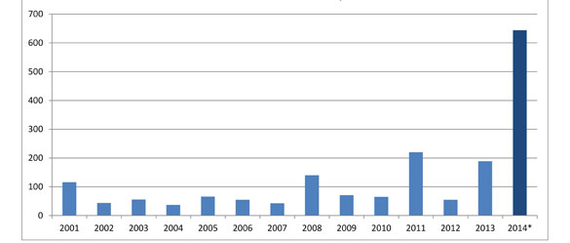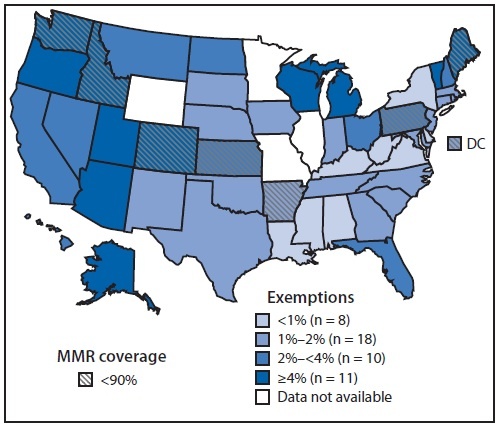
Before vaccination became widespread in the 1960s, pediatricians knew to check their patients' throats for the spray of telltale spots. Scientists raced for decades to develop an effective vaccine. And in the meantime, newspapers printed matter-of-fact death tolls, tallying high numbers of deaths by measles, scarlet fever, smallpox, and other illnesses of the recent past.
People expected to get measles in those days, but they didn't expect to survive. Measles killed some 2.6 million people each year before vaccination was widespread, according to the World Health Organization. Today, some 145,000 people die of measles each year—most of them because they lack access to the vaccine—and just a tiny fraction of them are in the United States, where the vaccine is readily available and widely used.
Traces of measles' one-time ubiquity in the States still linger in morbid nursery rhymes ("Cat's got the measles and the measles have got you," one goes) and splotchy illustrations in old children's books and medical texts, but vaccination has changed the way people see the illness in the developed world.
Culturally, measles is rarely seen as a threat anymore in the United States—a misconception that the disease isn't as dangerous as it actually is.
In reality, measles never went away.
At the petri-dish level, the virus—one of the most stable, unchanging strains there is—looks just the way it did in the pre-vaccination era. Measles remains one of the most infectious illnesses on the planet. The virus stays active and contagious in the air for up to two hours, and can be transmitted from an infected person for up to four days before and after a rash appears.
The stability of the measles virus is also what makes its vaccine so effective. "Oftentimes viruses mutate a lot, like the influenza virus, but this virus is very stable," said Cody Meissner, a professor of pediatrics at Tufts University School of Medicine. "There's really only one strain of the measles virus."
And although the United States successfully eradicated it—meaning that despite occasional outbreaks, measles doesn't move through the population continuously—there's no guarantee it will stay that way. That's what happened in the United Kingdom, where measles was wiped out but is now endemic again.
"It can definitely come back," Meissner told me. "And then because this is probably the most infectious of all the known viruses or illnesses—we say that about 90 percent of people who are not immune and who are exposed to measles will get it—that's a higher number than for any illness, even influenza. It's one of the most infectious or transmissible viruses that we're aware of."
Measles is already one of the leading causes of death among young children worldwide. About 400 people die from the virus each day—that's about 16 deaths every hour, according to the WHO. "It's a very severe disease," Meissner told me. "It's not a mild illness like mumps or even chickenpox. This is a much more severe sort of illness." Even those who survive the virus can suffer brain swelling, pneumonia, deafness, and other permanent complications. And in the United States, measles seems to be making a comeback. Today there are 67 confirmed measles cases in the United States, most of them linked to Disneyland in California. This puts the United States on pace to eclipse incidences of measles in 2014, which was already the worst year for measles since 1994, when there were 958 cases reported to the CDC. Last year there were 644 cases of measles reported in 27 states.
"It is very easy for entire communities to be exposed when an unvaccinated individual is infected and brings it into that group," said Roberta DeBiasi, the chief of Pediatric Infectious Diseases at Children's National Medical Center.
U.S. Measles Cases by Year

"The problem is people not getting vaccinated," said Jane Seward, deputy director of the Division of Viral Diseases at the Centers for Disease Control and Prevention. "The vast majority of our cases every single year are unvaccinated people who choose not to be vaccinated. They are living in a family who are unvaccinated and they have friends who are unvaccinated. They might go to a school with a high proportion of people who are unvaccinated."
That's true in parts of California, which has developed a reputation for communities where anti-vaccine attitudes thrive. Some 8 percent of kindergarteners enrolled in California schools have exemptions from the measles vaccine, according to CDC data. Some California schools have exemption rates as high as 43 percent, according to data compiled by the data-visualization platform Silk:
The CDC estimates other states—including Pennsylvania, Maine, and Colorado—have even higher rates of exemptions statewide.
Measles Vaccine Exemptions by State
In the wake of the Disneyland outbreak, health officials in Orange County have ordered dozens of high schoolers without proof of immunization to stay home from school, according to the Los Angeles Times.
To complicate matters further, there's an entire generation of doctors in the United States who have never treated a measles patient, or even seen a case in person. "The success in general of the vaccination program does mean that younger physicians have never seen a case, and they don't necessarily think about it at all," Seward told me. "The other challenge, which is nobody's fault at all, is that measles presents early on looking just like an upper-respiratory infection with fever. But it can be contagious before the rash. At that stage it's not distinguishable from the flu or other respiratory viruses."
Seward says the CDC has been making a "huge effort" to educate physicians. "We've really tried to hammer home the message that if you see somebody with a febrile rash illness, ask them if they've gone overseas, ask them about measles in their community, and ask them about their vaccination status. Think of measles."
The CDC recommends two doses of the vaccine for babies beginning at 1 year old, but 6-month-olds who are traveling out of the country should get an earlier dose, too, Seward and Meissner said. The majority of measles cases in the United States come from people who bring the virus back to the country from places where measles is still (or has become again) endemic—including the United Kingdom, France, and Canada, countries that many U.S. travelers don't identify as potentially dangerous from a public-health perspective, several physicians told me.
"The vaccine is extremely safe," Meissner said. "No vaccine is completely without side effects. The CDC is quick to acknowledge that. You can get a sore arm. You can get swelling and tenderness. You can get a fever. That is true. But the likelihood of having a severe complication from the vaccine is so remote that it's hard to quantify."
And though some of the treatments for complications associated with measles are more sophisticated today than they were in the pre-vaccination era, measles is just as deadly as ever. "If you go into shock, treatment of shock has probably improved," Seward told me, "But none of the treatments have changed that are going to alter the risk of death if you have a really bad case of measles.

Most people who got the measles in the united states expected to survive, and did survive prior to the vaccine. You can easily find the statistics showing the death rate in the united states from measles. Sanitation, clean hands, and healthy drinking water did more to protect people from disease than vaccines ever have. Not saying vaccines don't have a place. But focusing on sanitation, and clean water over the entire world would drop the death rate down to the .0000025 % that it was in the united states prior to Vaccination. Cases of measles are up. 650 least year. 15-25 were hospitalized. The rest recovered on their own -- sanitation and clean drinking water. Nobody died.
ReplyDelete